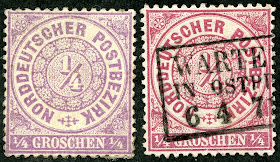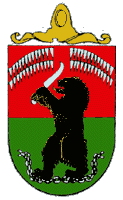1872 Germany Scott 10 7kr ultramarine
Imperial Eagle with Small Shield
Into the Deep Blue
WW collectors love to peek at what other WW collectors are adding to their collections.
In my case, I have close to 50,000 of the 83,000 major number stamp possibilities for the classical 1840-1940 (-1952 British Commonwealth) era.
One would think that any additional stamps would be of interest, as they would appear to be toward the "uncommon" range of the availability distribution bell curve..
Want to take a look at what I added during February of this year?
France Offices in China additions
100 Centimes = 1 Franc
100 Cents = 1 Piaster
100 Cents = 1 Dollar
France Offices in China
1894-1900 Scott 9 50c carmine/rose, Type I
Peace and Commerce Stamps of France, OP in Red, Carmine, or Black
I had a feeder collection of France that had some stamps in the "Offices in China" category that I did not have. What are "Offices in China" stamps? Well, before 1923 many of the major world powers maintained their own post offices in China for sending and receiving overseas mail.
Between 1904-1900, "Peace and Commerce" stamps of France were overprinted for use in China.
CV for the 13 major numbers range from $3 to $60. With this stamp, I have eight spaces filled.
France Offices in China
1907 Scott 59 6c on 15c pale red "Rights of Man"
Stamps of 1902-03 Surcharged in Black
In 1907, eight stamps of Indo-China 1902-03 were surcharged in black as shown. This one (CV $2+) I did not have yet, although I had four of the others.
France Offices in China
1907 Scott 62 20c on 50c bister brown & lavender
"Liberty and Peace"
Stamps of 1902-03 Surcharged in Black
I also added Scott 62 (CV $3+) for the 1907 issue.
Note that the CVs for the two stamps I added above under the "Offices in China" category are not that high. Still room to grow without necessarily spending $$$. !!!
France Offices in China
1907 Issue
Although I have a reasonably good collection of classic regular and semi-postal France, a reality check: I have 895 stamps out of 1932 possibilities. Most of the missing stamps are in the BOB categories.
Offices in China: Canton
Offices in China: 1901 Canton Scott 5
15c blue, quadrille paper, "Navigation & Commerce"
Stamps of Indo-China, 1892-1900, OP in Red
For Canton, in 1901, sixteen major number stamps were released, overprinted in red, on 1892-1900 Indo-China stamps. CV ranges from $2+ to $600! I have seven stamps in this issue with the addition of the 15c blue (CV $6+). Note the Chinese characters read "Canton".
Offices in China: Canton, Perf 14 X 13.5
1903-04 Scott 22 25c blue "Navigation & Commerce"
Surcharged in Black
In 1903-04, sixteen stamps of Indo-China were surcharged in black. The Chinese characters restate the denomination of the stamp.This Scott 22 is CV $7+.I have five other stamps filled for the issue.
Closeup- Navigation and Commerce
Genuine: Large Fruit well defined
OK, this is where it gets sticky
forgery wise.
The 1896 French Colonies "Navigation and Commerce" issue was forged by the Swiss forger Charles Hirschburger (later sold through Panelli). The forgeries are sometimes mistakenly attributed to Fournier. The forgeries consist of essentially
all of the French colonies "Navigation and Commerce" stamps, including most of the overprinted/surcharged stamps. Altogether, there are some 1400 forged unique stamps- a lot! What that means is essentially every "Navigation and Commerce" French colony stamp needs to be examined for this forgery.
Offices in China: Canton, Perf 13.5 X 14
"1903-04 Scott 16 2c brown/buff " "Navigation & Commerce"
Surcharged in Black
Hirschburger Forgery
Among my feeder album was this.
Closeup-Navigation and Commerce
Hirschburger Forgery: Large Fruit not well defined
There are lots of ways to tell if one has a forgery, as throughout the design the forged specimen is more crudely drawn. One way is to examine the fruit.
Mongolia additions
100 Cents = 1 Dollar
100 Mung = 1 Tugrik (1926)
1926-29 Scott 33 20m blue & black
Type I, 22 X 28 mm
Mongolia is exotic enough that any stamp addition is worthwhile. These stamps were found on the internet.
This lithographic 1926-29 type stamp ( 12 stamps in the issue) has a Type I design: the pearl above the crescent is solid. CV is $24..
1926-29 Scott 41 50m buff & black
Type II, 26 X 34 mm
The 50m buff & black is Type II: the pearl above the crescent is open and outlined in black.
CV is $6+.
North German Confederation or Germany additions
30 Groschen = 1 Thaler (Northern District, North German Confederation)
30 Silbergroschen or Groschen = 1 Thaler
60 Kreuzer = 1 Gulden
100 Pfennigs = 1 Mark (1875)
North German Confederation
1869 Scott 13 1/4gr lilac/ 1869 Scott 13a 1/4gr red violet
Most WW collectors who have been collecting awhile will have a very solid representation for Germany, as the stamps are plentiful in feeder collections, and dealer stocks. So any additions tend to be special.
So here, for the North German Confederation, I added a minor number color: a Scott 13a red violet. CV is $20.
1872 Germany Scott 11 18kr bister
Imperial Eagle with Small Shield
I already had most "Small Shield" 1872 Germany, missing only the 7kr ultramarine (CV $85) and the 18kr bister (CV $360). These were picked up through an exceptional feeder album.
1872 Scott 19 2 1/2gr orange brown
Imperial Eagle with Large Shield
The "Large Shield" 1872 Scott 19 was also added. CV is $60+.
1900 Scott 65A 5m slate & carmine, Type II
"Wilhelm II Speaking at Empire's 25th Anniversary Celebration"
This is the class of the Germany additionals: an unused Scott 65A. Lovely, lovely! CV is $375.
1902 Scott 76 2m gray blue
"Union of North and South Germany"
The 1902 2m gray blue was also picked up. CV (unused) is $80+.
1923 Scott 242A 8th m on 30 pf
Wmk Network (126)
The Wmk Network 8th m on 30pf is hard to find. It has a CV of $20+(unused), compared to the Wmk Lozenges variety (CV $<1).
Germany Scott 242A back
Wmk Network (126)
Evidence that this is the Wmk Network version!
1927 Scott 365 25pf blue
Overprinted
One of my missing sets was the overprinted "I.A.A." three stamp release of October 10, 1927.
Scott 363-365 1927 Issue
The CV is $10+ unused. "I.A.A." stands for "Internationales Arbeitsamt", an agency of the League of Nations, that was meeting in Berlin.
1933 Scott 414 100pf orange & black "Hindenburg"
Wmk Network (126)
The 100pf orange & black "Hindenburg" (as well as other denominations) are more common in feeder collections with the "Swastikas" watermark (CV $3+) (1933-36 issue) than the "Network" watermark (CV $25) (1933 Issue).
1933 Scott 414 Back
Wmk Network (126)
Unfortunately, in feeder collections, stamps that are placed into the 1933 Hindenburg spaces often have the "Swastikas" watermark: which actually belongs to the 1933-36 issue.
But here is proof that the 100pf orange & black shown here has a "Network" watermark, a 1933 issue.
Mongolia 1926-29 Scott 39 25m yellow green & Black
Type II, 22 X 29 mm
Out of the Blue
O.K., end of this "Show & Tell". ;-)
To be continued with others in the future.
Comments appreciated!


























































